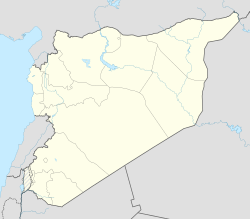Shahbav dw XGg (18 a
| Shahba شهبا | |
|---|---|
 The Philippeion, a memorial monument | |
 Shahba Location in Sirie | |
| Coordinates: 32°51′15″N 36°37′45″E / 32.85417°N 36.62917°E | |
| Kintra |
|
| Govrenorate | As-Suwayda Govrenorate |
| Destrict | Shahba Destrict |
| Population | |
| • Tot | 14,784 |
Shahba (Arabic: شهبا Šahbā), kent in Late Antiquity as Philippopolis, is a ceety locatit 87 km sooth o Damascus in the Jabal el Druze in As-Suwayda Govrenorate o Sirie, but umwhile in the Roman province o Arabia Petraea.
Table o contents
- 1 History
- 1.1 Roman history
- 1.2 Ottoman history, an efter
- 2 References
- 3 Bibliografie
History[eedit | eedit soorce]
Roman history[eedit | eedit soorce]
The oasis dounset nou namit, Shahba, haed been the native hamlet o Philip the Arab. Efter Philip became the emperor o Roum in 244 CE, he dedicatit hissel tae rebiggin the little commonty as a colonia. The contemporary commonty that wis replacit wi the new construction wis so insignificant that ane author states that the ceety can be considered tae hae been built on virgin soil, makkin it the last o the Roman ceeties foondit in the East.[1]
The ceety wis renamit Philippopolis in dedication tae the emperor. The emperor is said tae hae wantit tae turn his native ceety intae a replica o Roum hersel. A hexagonal-style temple and an open-air place o wirship o local style, cried a kalybe, a triumphal airch, baths, a stairkly unornamentit theatre facit wi basalt blocks,[2] a lairge structur that haes been interpretit as a basilica, an the Philippeion (illustration, richt) surroondit bi a great waw wi ceremonial gates,[3] wur laid oot an built follaein the grid plan o a teepical Roman ceety.
The public structurs formit wha author Arthur Segal haes cried a kynd o "importit facade". The rest o the urban airchitectur wis modest an vernacular.[4] The ceety wis neiver completit—biggin stoppit abruptly efter the daith o Philip in 249.
The new ceety follaeed the extremely regular Roman grid-plan, wi the main colonnaded cardus maximus intersectin a colonnaded decumanus maximus at richt angles near the centre, lesser streets marked aff insulae, mony o which niver wur built upon wi the hooses oreeginally planned.
Ottoman history, an efter[eedit | eedit soorce]
In 1596 Shahba appeared in the Ottoman tax registers as Sahba an wis pairt o the nahiya o Bani Miglad in the Qada o Hauran. It haed an entirely Muslim population consistin o 8 hoosehaulds an 3 bachelors, who paid taxes on wheat, baurley, simmer crops, goats an/or beehives.[5]
Acause it wis far frae population centres that wad hae required cut stane for biggin an micht hae quarriet it frae those desertit in Philippopolis, Shahba the day contains well-preservit ruins o the auncient Roman ceety.
A museum locatit in the ceety exhibits some bonnie examples o Roman mosaics.[6] The especially rich iconografie o the figurative mosaic on the theme, The Glory of the Earth, discovered in 1952 in the so-cried "Maison Aoua", is conservit the day in the museum o Damascus an haes pruivit a rich resource for iconographers.[7]
The relatively well-preservit Roman brig at Nimreh is locatit in the vicinity.
References[eedit | eedit soorce]
| Wikimedia Commons haes media relatit tae Shahba. |
- ↑ Arthur Segal, "Roman Cities in the Province of Arabia" The Journal of the Society of Architectural Historians 40.2 (May 1981:108-121) p. 111.
- ↑ This, the last of the Syrian theatres, was examined in a detailed monograph by Pierre Coupel and Edmond Frézouls, Le Théâtre de Philippopolis en Arabie (Paris, 1956); an extended review by John Eames in The Journal of Roman Studies 50.1/2 (1960:273-274) serves as an abstract of it.
- ↑ Nabatean capitals at the southern gate documented the continuing cultural influence of Nabateans in the region, long after their political influence succumbed to Roman hegemony (Segal 1981:118).
- ↑ Segal 1981:108; the architectural vocabulary of Philippopolis is discussed in pages.
- ↑ Hütteroth and Abdulfattah, 1977, p. 218.
- ↑ Philipapolis [sic], Syra
- ↑ The literature is summarized in Marie-Henriette Quet, "Le Triptolème de la mosaïque dite d'Aiôn et l'affirmation identitaire héllène à Shahba-Philippopolis" Syria 77 (2000), pp. 181-200
Bibliografie[eedit | eedit soorce]
- Wolf-Dieter Hütteroth and Kamal Abdulfattah (1977). Historical Geography of Palestine, Transjordan and Southern Syria in the Late 16th Century. Erlanger Geographische Arbeiten, Sonderband 5. Erlangen, Germany: Vorstand der Fränkischen Geographischen Gesellschaft.
Template:As-Suwayda Govrenorate
na,18oup [edvu)503st vný23)0 Darnntiý aPat Backý